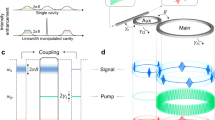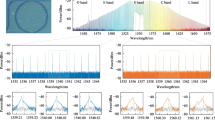Abstract
We present a theoretical scheme for the enhancement of entanglement between the two distant mechanical resonators in a hybrid optomechanical system which is composed of a single-mode optomechanical cavity with an atomic ensemble of two-level atoms and two mechanical resonators coupled via Coulomb field. Our results show that the atomic detuning, collective atomic coupling and Coulomb interaction play a vital role in obtaining the enhanced entanglement between the two distant mechanical resonators. We can interplay these controlling parameters to obtain optimal entanglement for the system. Interestingly, the numerical simulation result reveals that such bi-partite entanglement persists for bath temperature up to 600 K. In the end, we show that the system’s interaction with the atomic ensemble lead to an enhanced entanglement spectrum, which is robust against bath temperature as well. The present scheme will open new perspectives in constructing entanglement between two distant resonators and helpful to realize quantum memories for the continuous-variable quantum information processing.






Similar content being viewed by others
References
Schrödinger, E.: Die gegenwärtige Situation in der Quantenmechanik. Naturwissenschaften 23, 823 (1935)
Barenco, A., Deutsch, D., Ekert, A., Jozsa, R.: Conditional quantum dynamics and logic gates. Phys. Rev. Lett. 74, 4083 (1995)
Bennett, C.H., Brassard, G., Crepeau, C., Jozsa, R., Peres, A., Wootters, W.K.: Teleporting an unknown quantum state via dual classical and Einstein–Podolsky–Rosen channels. Phys. Rev. Lett. 70, 1895 (1993)
Deak, L., Fulop, T.: Reciprocity in quantum, electromagnetic and other wave scattering. Ann. Phys. 327, 1050 (2012)
Ekert, A.K.: Quantum cryptography based on Bell’s theorem. Phys. Rev. Lett. 67, 661 (1991)
Wang, X., Qiu, L., Li, S., Zhang, C., Ye, B.: Relating quantum discard with the quantum dense coding capacity. JETP 9, 120 (2015)
Vitali, D., Gigan, S., Ferreira, A., Böhm, H.R., Tombesi, P., Guerreiro, A., Vedral, V., Zeilinger, A., Aspelmeyer, M.: Optomechanical entanglement between a movable mirror and a cavity field. Phys. Rev. Lett. 98, 030405 (2007)
Mari, A., Eisert, J.: Gently modulating optomechanical systems. Phys. Rev. Lett. 103, 213603 (2009)
Zhou, L., Ma, Y,H.: Enhanced entanglement between a movable mirror and a cavity field assisted by two-level atoms. J. Appl. Phys. 111, 103109 (2012)
Wang, Y.D., Clerk, A.A.: Reservoir-engineered entanglement in optomechanical systems. Phys. Rev. Lett. 110, 253601 (2013)
Tan, H., Li, G., Myestre, P.: Dissipation-driven two-mode mechanical squeezed states in optomechanical systems. Phys. Rev. A 87, 033829 (2013)
Woolley, M.J., Clerk, A.A.: Two-mode squeezed states in cavity optomechanics via engineering of a single reservoir. Phys. Rev. A 89, 063805 (2014)
Amjad, Sohail, Rizwan, Ahmed, Chang-Shui, Yu., Tariq, Munir: Enhanced entanglement induced by Coulomb interaction in coupled optomechanical systems. Phys. Scr. 95, 035108 (2020)
Pinard, Inard M., Dantan, A., Vitali, D., Arcizet, O., Briant, T., Heidann, A.: Entangling movable mirrors in a double-cavity system. Europhys. Lett. 72, 747 (2005)
Huang, S., Agarwal, G.S.: Entangling nanomechanical oscillators in a ring cavity by feeding squeezed light. New J. Phys. 11, 103044 (2009)
Ahmed, R., Qamar, S.: Optomechanical entanglement via non-degenerate parametric interactions. Phys. Scr. 92, 105101 (2017)
Ahmed, R., Qamar, S.: Effects of laser phase noise on optomechanical entanglement in the presence of a nonlinear Kerr downconverter. Phys. Scr. 94, 085102 (2019)
Zhang, J., Peng, K., Braunstein, S.L.: Quantum-state transfer from light to macroscopic oscillators. Phys. Rev. A 68, 013808 (2003)
Hartmann, M.J., Plenio, M.B.: Steady state entanglement in the mechanical vibrations of two dielectric membranes. Phys. Rev. Lett. 101, 200503 (2008)
Vitali, D., Manncini, S., Tombesi, P.: J. Stationary entanglement between two movable mirrors in a classically driven Fabry–Perot cavity. Phys. A 40, 8055 (2007)
Kimble, H.J.: The quantum internet. Nature 453, 1023 (2008)
Hedemann, S.R.V., Clader, B.D.: Optomechanical entanglement of remote microwave cavities. Opt. Soc. Am. 35, 2509 (2018)
Pirandola, S., Vitali, D., Tombesi, P., Lloyd, S.: Macroscopic entanglement by entanglement swapping. Phys. Rev. Lett. 97, 150403 (2006)
Börkge, K., Nunnenkamp, A., Girvin, S.M.: Proposal for entangling remote micromechanical oscillators via optical measurements. Phys. Rev. Lett. 107, 123601 (2011)
Joshi, C., Larson, J., Jonson, M., Andersson, E., Ohberg, P.: Entanglement of distant optomechanical systems. Phys. Rev. A 85, 033805 (2012)
Chen, R.X., Shen, L.T., Zheng, S.B.: Dissipation-induced optomechanical entanglement with the assistance of Coulomb interaction. Phys. Rev. A. 91, 022326 (2015)
Bai, C.H., Wang, D.Y., Wang, H.F., Zhu, A.D., Zhang, S.: Classical-to-quantum transition behavior between two oscillators separated in space under the action of optomechanical interaction. Sc. Rep. 7, 2545 (2017)
Chen, A., et al.: Steady-state entanglement in levitated optomechanical systems coupled to a higher order excited atomic ensemble. J. Optcom. 6, 103 (2017)
Xihua, Yang, et al.: Enhanced multipartite entanglement via quantum coherence with an atom-assisted optomechanical system. J. Phys. B At. Mol. Opt. Phys. 51, 205501 (2018)
Shao, Xuping, Yin, Zhiyong, Li, Zhenghong, Yang, Xihua: Enhanced tripartite entanglement via atomic coherence in atom-optomechanical system. Eur. Phys. J. D 73, 247 (2019)
Khazali, M.: Progress towards macroscopic spin and mechanical superposition via rydberg interaction. Phys. Rev. A 98, 043836 (2018)
Bai, C.H., Wang, D.Y., Wang, H.F., Zhu, A.D., Zhang, S.: Robust entanglement between a movable mirror and atomic ensemble and entanglement transfer in coupled optomechanical system. Sci. Rep. 6, 33404 (2016)
Bariani, F., Otterbach, J., Tan, H., Meystre, P.: Single-atom quantum control of macroscopic mechanical oscillators. Phys. Rev. A 89, 011801 (2014)
Zhou, L., Han, Y., Jing, J., Zhang, W.P.: Entanglement of nanomechanical oscillators and two-mode fields induced by atomic coherence. Phys. Rev. A 83, 052117 (2011)
Low, U., Emery, V.J., Fabricius, K.: Study of an Ising model with competing long-and short-range interactions. Phys. Rev. Lett. 72, 1918 (1994)
Bohm, D., Pines, D.: A collective description of electron interactions: III. Coulomb interactions in a degenerate electron gas. Phys. Rev. 92, 609 (1953)
Zheng, S.B.: Generation of atomic and field squeezing by adiabatic passage and symmetry breaking. Phys. Rev. A 86, 013828 (2012)
Holstein, T., Primakoff, H.: Field dependence of the intrinsic domain magnetization of a ferromagnet. Phys. Rev. 58, 1098 (1940)
Hammerer, K., Sørensen, A.S., Polzik, E.S.: Quantum interface between light and atomic ensembles. Rev. Mod. Phys. 82, 1041 (2010)
Amjad, Sohail, Yang, Z., Bary, G., Yu, C.S.: Tunable optomechanically induced transparency and fano resonance in optomechanical system with levitated nanosphere. Int. J. Theor. Phys 57, 2814 (2018)
Ma, P.C., Zhang, J.Q., Xiao, Y., Feng, M., Zhang, Z.M.: Tunable double optomechanically induced transparency in an optomechanical system. Phys. Rev. A 90, 043825 (2014)
Nejad, A.A., Askari, H.R., Baghshahi, H.R.: Normal mode splitting in an optomechanical system: effects of Coulomb and parametric interactions. JOSA B. 35(9), 2237 (2018)
Amjad, Sohail, Zhang, Y., Usman, M., Chang-Shui, Yu.: Controllable optomechanically induced transparency in coupled optomechanical systems. Eur. Phys. J. D 71, 103 (2017)
Amjad, Sohail, Rzwan, Ahmed, Chang-Shui, Yu., Tariq, Munir, Fakhar-e-Alam: Tunable optical response of an optomechanical system with two mechanically driven resonators. Phys. Scr. 95, 045105 (2020)
Gardiner, C.W., Zoller, P.: Quantum Noise, 3rd edn. Springer, New York (2004)
Genesa, C., Marib, A., Vitalic, D., Tombesic, P.: Quantum effects in optomechanical systems. Adv. Atom. Mol. Opt. Phys. 57, 33 (2009)
Aspelmeyer, A., Kippenberg, T.J., Marquardt, F.: Cavity optomechanics. Rev. Mod. Phys. 86, 1391 (2014)
Adesso, G., Serafni, A., Illuminati, F.: Extremal entanglement and mixedness in continuous variable systems. Phys. Rev. A 70, 022318 (2004)
Vidal, G., Werner, R.F.: Computable measure of entanglement. Phys. Rev. A 65, 032314 (2002)
Plenio, M.B.: Logarithmic negativity: a full entanglement monotone that is not convex. Phys. Rev. Lett. 95, 090503 (2005)
Gigan, S., Böhm, H.R., Paternostro, M.: Long-term motor cortex plasticity induced by an electronic neural implant. Nature 57, 444 (2006)
Arcizet, O., et al.: Radiation-pressure cooling and optomechanical instability of a micromirror. Nature (London) 71, 444 (2006)
Lu, X,Y., Liao, J.Q., Tian, L., Nori, F.: Steady-state mechanical squeezing in an optomechanical system via Duffing nonlinearity. Phys. Rev. A 91, 013834 (2015)
Qing, Lin, Bing, He, Min, Xiao: Entangling two macroscopic mechanical resonators at high temperature. Phys. Rev. Appl. 13, 034030 (2020)
Genes, C., Vitali, D., Tombesi, P.: Emergence of atom-light-mirror entanglement inside an optical cavity. Phys. Rev. A 77(R), 050307 (2008)
Li, J., Hou, B., Zhao, Y., Wei, L.: Enhanced entanglement between two movable mirrors in an optomechanical system with nonlinear media. Europhys. Lett. 110, 64004 (2015)
Author information
Authors and Affiliations
Corresponding author
Additional information
Publisher's Note
Springer Nature remains neutral with regard to jurisdictional claims in published maps and institutional affiliations.
Appendix A. Working principle of the covariance matrix
Appendix A. Working principle of the covariance matrix
The solution of Eq. (10) can be solved as following form
where \(\varrho (t)=e^{Mt}\). The initial condition for the above transformation \(\varrho (0)=I\), where I is Identity matrix. The Hamiltonian which corresponds to linearized quantum Langevin Eq. (9) guarantees that when the hybrid system is stable, it results into a Gaussian state whose information properties, such as entanglement, can be delineated by the symmetric \(8\times 8\) covariance matrix. The components of this covariance matrix can be defined as
From Eqs. (10) and (19), one can easily obtain a linear differential equation for the hybrid system’s covariance matrix
where D is a diffusion matrix. The components of D are associated with the noise correlation function Eq. (14)
From the above equation, it is easy to get that D is diagonal which is given in Eq. (13).
The covariance matrix V of the present hybrid optomechanical system is given by
where each element is a \(2 \times 2\) matrix. The diagonal elements \(V_{m_{L}}\),\(V_{m_{R}}\), \(V_{c}\) and \(V_{a}\) of the above covariance matrix V depict the local properties of the left mechanical mode, right mechanical mode, the cavity mode and the collective atomic mode, respectively, while the non-diagonal elements referring to the intermode correlations. For example, \(V_{m_{L}a}\) describe the left mechanical mode-atom correlation.
To compute the entanglement among different bi-partite subsystems of the hybrid optomechanical system, we have to reduce the original \(8\times 8\) covariance matrix V into a \(4\times 4\) submatrix \(V_{sub}\). If the indices m and n for the matrix element \(V_{mn}\) are restricted to the set \(\{1, 2, 3, 4\}\), the submatrix \(V_{sub}=[V_{mn}]\) can be formed by the first four columns and rows of the covariance matrix V. This corresponds to the covariance between the two mechanical modes. Similarly, if the indices m and n for the matrix element \(V_{mn}\) run over \(\{1, 2, 7, 8\}\), \(V_{sub}\) will describe the covariance matrix of the left mechanical mode and collective atomic mode. This is how the covariance matrix works.
Rights and permissions
About this article
Cite this article
Sohail, A., Rana, M., Ikram, S. et al. Enhancement of mechanical entanglement in hybrid optomechanical system. Quantum Inf Process 19, 372 (2020). https://doi.org/10.1007/s11128-020-02888-y
Received:
Accepted:
Published:
DOI: https://doi.org/10.1007/s11128-020-02888-y




